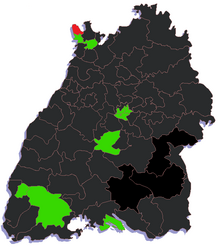Baden-Württemberg state election, 2011
|
|
|||||||||||||||||||||||||||||||||||||||||||||||||||||||||||||||||||||||||||||||||||||
|
|||||||||||||||||||||||||||||||||||||||||||||||||||||||||||||||||||||||||||||||||||||
|
|||||||||||||||||||||||||||||||||||||||||||||||||||||||||||||||||||||||||||||||||||||
|
|
|||||||||||||||||||||||||||||||||||||||||||||||||||||||||||||||||||||||||||||||||||||
| Seats won by party black = absolute majority for CDU grey = plurality for CDU green = plurality for Greens red = plurality for SPD |
|||||||||||||||||||||||||||||||||||||||||||||||||||||||||||||||||||||||||||||||||||||
|
|||||||||||||||||||||||||||||||||||||||||||||||||||||||||||||||||||||||||||||||||||||
The Baden-Württemberg state election 2011 was held on 27 March 2011 to elect members to Baden-Württemberg's State diet, the Landtag of Baden-Württemberg in Stuttgart. It was the 14th state election since the foundation of Baden-Württemberg in 1952. Before, Stefan Mappus (CDU) had led a coalition government of his party with the FDP, which in the election lost its majority to Alliance '90/The Greens, who scored their all-time best state election result, and the Social Democrats.
Like in all German states, elections in Baden-Württemberg follow the mixed member proportional representation. There are 70 constituency seats and at least 50 additional seats to be filled, making up a total of seats of at least 120. A higher number can be reached through overhang seats and additional seats to restore proportional representation. Unlike all other states, there are no party lists. Instead, the seats for a party which are not filled by constituency winners go to the party's remaining constituency candidates with the highest percentages of votes. For the first time, the Sainte-Laguë method was used to calculate the seat allocation.
...
Wikipedia





